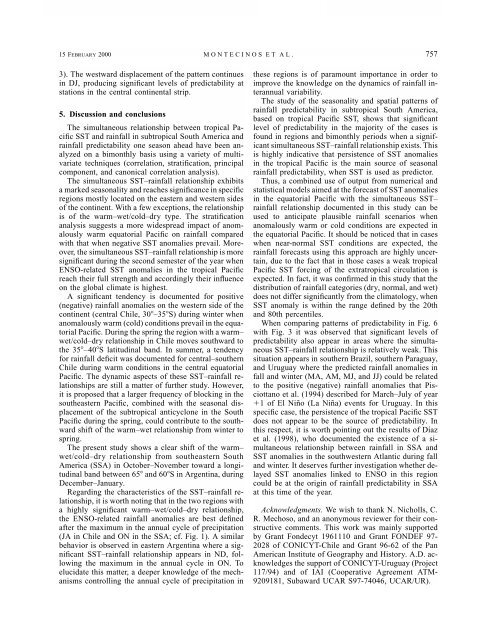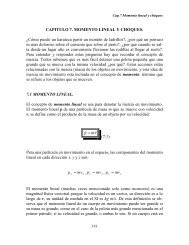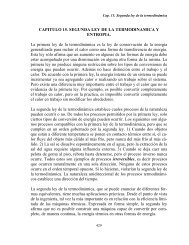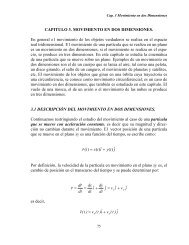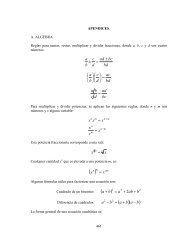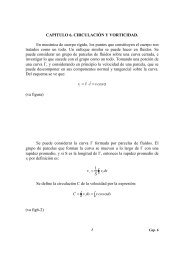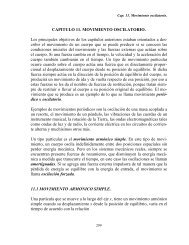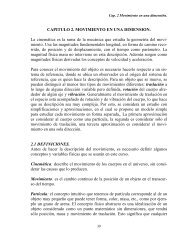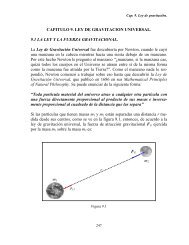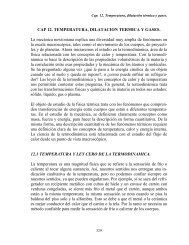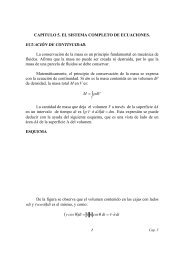Seasonal Diagnostic and Predictability of Rainfall in Subtropical ...
Seasonal Diagnostic and Predictability of Rainfall in Subtropical ...
Seasonal Diagnostic and Predictability of Rainfall in Subtropical ...
Create successful ePaper yourself
Turn your PDF publications into a flip-book with our unique Google optimized e-Paper software.
15 FEBRUARY 2000 MONTECINOS ET AL.<br />
757<br />
3). The westward displacement <strong>of</strong> the pattern cont<strong>in</strong>ues<br />
<strong>in</strong> DJ, produc<strong>in</strong>g significant levels <strong>of</strong> predictability at<br />
stations <strong>in</strong> the central cont<strong>in</strong>ental strip.<br />
5. Discussion <strong>and</strong> conclusions<br />
The simultaneous relationship between tropical Pacific<br />
SST <strong>and</strong> ra<strong>in</strong>fall <strong>in</strong> subtropical South America <strong>and</strong><br />
ra<strong>in</strong>fall predictability one season ahead have been analyzed<br />
on a bimonthly basis us<strong>in</strong>g a variety <strong>of</strong> multivariate<br />
techniques (correlation, stratification, pr<strong>in</strong>cipal<br />
component, <strong>and</strong> canonical correlation analysis).<br />
The simultaneous SST–ra<strong>in</strong>fall relationship exhibits<br />
a marked seasonality <strong>and</strong> reaches significance <strong>in</strong> specific<br />
regions mostly located on the eastern <strong>and</strong> western sides<br />
<strong>of</strong> the cont<strong>in</strong>ent. With a few exceptions, the relationship<br />
is <strong>of</strong> the warm–wet/cold–dry type. The stratification<br />
analysis suggests a more widespread impact <strong>of</strong> anomalously<br />
warm equatorial Pacific on ra<strong>in</strong>fall compared<br />
with that when negative SST anomalies prevail. Moreover,<br />
the simultaneous SST–ra<strong>in</strong>fall relationship is more<br />
significant dur<strong>in</strong>g the second semester <strong>of</strong> the year when<br />
ENSO-related SST anomalies <strong>in</strong> the tropical Pacific<br />
reach their full strength <strong>and</strong> accord<strong>in</strong>gly their <strong>in</strong>fluence<br />
on the global climate is highest.<br />
A significant tendency is documented for positive<br />
(negative) ra<strong>in</strong>fall anomalies on the western side <strong>of</strong> the<br />
cont<strong>in</strong>ent (central Chile, 30–35S) dur<strong>in</strong>g w<strong>in</strong>ter when<br />
anomalously warm (cold) conditions prevail <strong>in</strong> the equatorial<br />
Pacific. Dur<strong>in</strong>g the spr<strong>in</strong>g the region with a warm–<br />
wet/cold–dry relationship <strong>in</strong> Chile moves southward to<br />
the 35–40S latitud<strong>in</strong>al b<strong>and</strong>. In summer, a tendency<br />
for ra<strong>in</strong>fall deficit was documented for central–southern<br />
Chile dur<strong>in</strong>g warm conditions <strong>in</strong> the central equatorial<br />
Pacific. The dynamic aspects <strong>of</strong> these SST–ra<strong>in</strong>fall relationships<br />
are still a matter <strong>of</strong> further study. However,<br />
it is proposed that a larger frequency <strong>of</strong> block<strong>in</strong>g <strong>in</strong> the<br />
southeastern Pacific, comb<strong>in</strong>ed with the seasonal displacement<br />
<strong>of</strong> the subtropical anticyclone <strong>in</strong> the South<br />
Pacific dur<strong>in</strong>g the spr<strong>in</strong>g, could contribute to the southward<br />
shift <strong>of</strong> the warm–wet relationship from w<strong>in</strong>ter to<br />
spr<strong>in</strong>g.<br />
The present study shows a clear shift <strong>of</strong> the warm–<br />
wet/cold–dry relationship from southeastern South<br />
America (SSA) <strong>in</strong> October–November toward a longitud<strong>in</strong>al<br />
b<strong>and</strong> between 65 <strong>and</strong> 60S <strong>in</strong> Argent<strong>in</strong>a, dur<strong>in</strong>g<br />
December–January.<br />
Regard<strong>in</strong>g the characteristics <strong>of</strong> the SST–ra<strong>in</strong>fall relationship,<br />
it is worth not<strong>in</strong>g that <strong>in</strong> the two regions with<br />
a highly significant warm–wet/cold–dry relationship,<br />
the ENSO-related ra<strong>in</strong>fall anomalies are best def<strong>in</strong>ed<br />
after the maximum <strong>in</strong> the annual cycle <strong>of</strong> precipitation<br />
(JA <strong>in</strong> Chile <strong>and</strong> ON <strong>in</strong> the SSA; cf. Fig. 1). A similar<br />
behavior is observed <strong>in</strong> eastern Argent<strong>in</strong>a where a significant<br />
SST–ra<strong>in</strong>fall relationship appears <strong>in</strong> ND, follow<strong>in</strong>g<br />
the maximum <strong>in</strong> the annual cycle <strong>in</strong> ON. To<br />
elucidate this matter, a deeper knowledge <strong>of</strong> the mechanisms<br />
controll<strong>in</strong>g the annual cycle <strong>of</strong> precipitation <strong>in</strong><br />
these regions is <strong>of</strong> paramount importance <strong>in</strong> order to<br />
improve the knowledge on the dynamics <strong>of</strong> ra<strong>in</strong>fall <strong>in</strong>terannual<br />
variability.<br />
The study <strong>of</strong> the seasonality <strong>and</strong> spatial patterns <strong>of</strong><br />
ra<strong>in</strong>fall predictability <strong>in</strong> subtropical South America,<br />
based on tropical Pacific SST, shows that significant<br />
level <strong>of</strong> predictability <strong>in</strong> the majority <strong>of</strong> the cases is<br />
found <strong>in</strong> regions <strong>and</strong> bimonthly periods when a significant<br />
simultaneous SST–ra<strong>in</strong>fall relationship exists. This<br />
is highly <strong>in</strong>dicative that persistence <strong>of</strong> SST anomalies<br />
<strong>in</strong> the tropical Pacific is the ma<strong>in</strong> source <strong>of</strong> seasonal<br />
ra<strong>in</strong>fall predictability, when SST is used as predictor.<br />
Thus, a comb<strong>in</strong>ed use <strong>of</strong> output from numerical <strong>and</strong><br />
statistical models aimed at the forecast <strong>of</strong> SST anomalies<br />
<strong>in</strong> the equatorial Pacific with the simultaneous SST–<br />
ra<strong>in</strong>fall relationship documented <strong>in</strong> this study can be<br />
used to anticipate plausible ra<strong>in</strong>fall scenarios when<br />
anomalously warm or cold conditions are expected <strong>in</strong><br />
the equatorial Pacific. It should be noticed that <strong>in</strong> cases<br />
when near-normal SST conditions are expected, the<br />
ra<strong>in</strong>fall forecasts us<strong>in</strong>g this approach are highly uncerta<strong>in</strong>,<br />
due to the fact that <strong>in</strong> those cases a weak tropical<br />
Pacific SST forc<strong>in</strong>g <strong>of</strong> the extratropical circulation is<br />
expected. In fact, it was confirmed <strong>in</strong> this study that the<br />
distribution <strong>of</strong> ra<strong>in</strong>fall categories (dry, normal, <strong>and</strong> wet)<br />
does not differ significantly from the climatology, when<br />
SST anomaly is with<strong>in</strong> the range def<strong>in</strong>ed by the 20th<br />
<strong>and</strong> 80th percentiles.<br />
When compar<strong>in</strong>g patterns <strong>of</strong> predictability <strong>in</strong> Fig. 6<br />
with Fig. 3 it was observed that significant levels <strong>of</strong><br />
predictability also appear <strong>in</strong> areas where the simultaneous<br />
SST–ra<strong>in</strong>fall relationship is relatively weak. This<br />
situation appears <strong>in</strong> southern Brazil, southern Paraguay,<br />
<strong>and</strong> Uruguay where the predicted ra<strong>in</strong>fall anomalies <strong>in</strong><br />
fall <strong>and</strong> w<strong>in</strong>ter (MA, AM, MJ, <strong>and</strong> JJ) could be related<br />
to the positive (negative) ra<strong>in</strong>fall anomalies that Pisciottano<br />
et al. (1994) described for March–July <strong>of</strong> year<br />
1 <strong>of</strong>ElNiño (La Niña) events for Uruguay. In this<br />
specific case, the persistence <strong>of</strong> the tropical Pacific SST<br />
does not appear to be the source <strong>of</strong> predictability. In<br />
this respect, it is worth po<strong>in</strong>t<strong>in</strong>g out the results <strong>of</strong> Díaz<br />
et al. (1998), who documented the existence <strong>of</strong> a simultaneous<br />
relationship between ra<strong>in</strong>fall <strong>in</strong> SSA <strong>and</strong><br />
SST anomalies <strong>in</strong> the southwestern Atlantic dur<strong>in</strong>g fall<br />
<strong>and</strong> w<strong>in</strong>ter. It deserves further <strong>in</strong>vestigation whether delayed<br />
SST anomalies l<strong>in</strong>ked to ENSO <strong>in</strong> this region<br />
could be at the orig<strong>in</strong> <strong>of</strong> ra<strong>in</strong>fall predictability <strong>in</strong> SSA<br />
at this time <strong>of</strong> the year.<br />
Acknowledgments. We wish to thank N. Nicholls, C.<br />
R. Mechoso, <strong>and</strong> an anonymous reviewer for their constructive<br />
comments. This work was ma<strong>in</strong>ly supported<br />
by Grant Fondecyt 1961110 <strong>and</strong> Grant FONDEF 97-<br />
2028 <strong>of</strong> CONICYT-Chile <strong>and</strong> Grant 96-62 <strong>of</strong> the Pan<br />
American Institute <strong>of</strong> Geography <strong>and</strong> History. A.D. acknowledges<br />
the support <strong>of</strong> CONICYT-Uruguay (Project<br />
117/94) <strong>and</strong> <strong>of</strong> IAI (Cooperative Agreement ATM-<br />
9209181, Subaward UCAR S97-74046, UCAR/UR).


